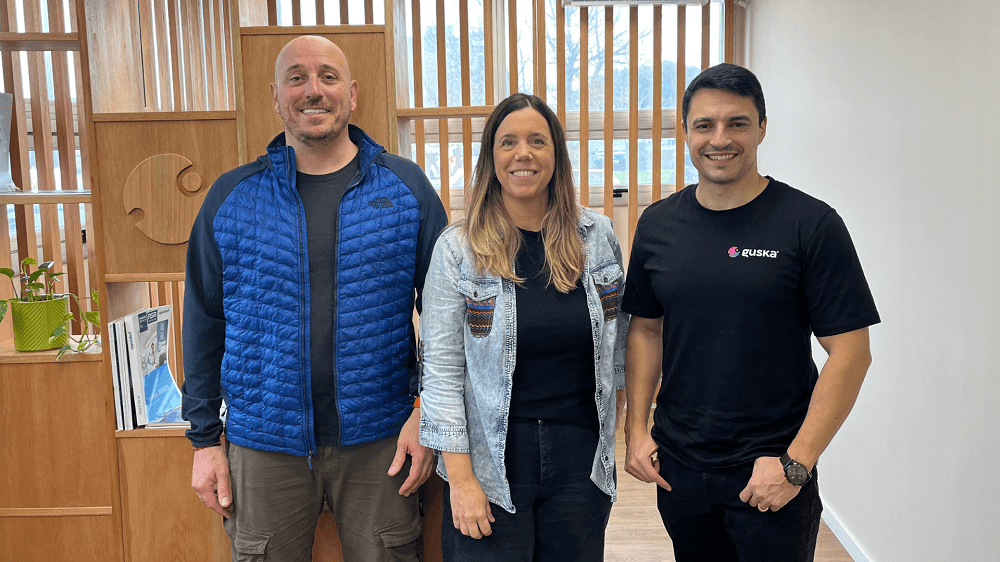In April 2025, Nicolás Tambucho joined Guska as CEO at the invitation of the startup’s founders, Gonzalo Moratorio and Pilar Moreno. Backed by LAB+, Guska develops oncolytic viruses that selectively attack tumor cells without harming healthy ones.
Before taking on this new role, Tambucho served as CEO and COO (Chief Operating Officer) of RADBIO, a science-based startup that develops innovative biopharmaceuticals for complex chronic diseases.
In this interview, he discusses the challenges of his new position, the new directions of Guska’s research, and the alliance with Marvik, one of the leading artificial intelligence companies in Uruguay and the region.
How did you come to join Guska, and what drove you to make this change?
I was still at my previous company, RADBIO, when I saw Gonzalo and Pilar present their work on oncolytic viruses, and I found it spectacular. It was a technology I hadn’t come across before, but one that really sparked my curiosity.
I spent seven years at RADBIO working on early-stage pharmaceutical development with innovative technologies, so I felt my experience could contribute to what Guska was building. After several conversations, Gonzalo and Pilar invited me to take on the role of CEO. Following internal discussions at RADBIO, we managed the transition, and in April of this year I officially started at Guska.
While each technology has its specific characteristics, early pharmaceutical development—and also business development and management—share niche aspects in both startups, very specific to this subfield of biotechnology.
I also took on this role with the intention of further strengthening Uruguay’s biotech ecosystem, which has grown significantly in recent years thanks to government support, new investment funds, and company builders like LAB+. In fact, LAB+ is the first Uruguayan company builder dedicated specifically to life sciences. It’s a major driver for the ecosystem, and I believe it will put Uruguay on the map for early-stage pharmaceutical development in the short to medium term—a niche that is very important both for scientific progress in health and for the country’s economy.
A few months ago, Guska decided to focus its research on brain tumors. How did that come about?
As everyone knows, Gonzalo was diagnosed with a brain tumor a few months ago. Following that, Pilar gathered the team and we decided to focus on generating efficacy and safety results to advance the study of our oncolytic viruses in glioblastoma, which are very aggressive brain tumors.
As a result, our current studies are more targeted to this indication. That said, we are continuing our work on other tumor types where we already demonstrated efficacy in animal models, such as lung and pancreatic cancer. Importantly, we also obtained safety results, which are especially relevant with this type of technology. Those projects are continuing in parallel.
In August, Guska announced an agreement with Marvik. What does it involve?
The agreement came about because we wanted to strengthen the development of two oncolytic viruses designed with our own patented technologies. We are advancing them for several indications: lung, pancreas, and more recently, breast cancer and brain tumors.
With input from our collaborator Antonio Bordería, we decided to apply artificial intelligence tools to build a generative platform that would accelerate the development of new viruses, enable us to design viruses with attenuation technologies (which make them safe), and target them to specific tumor types—or even to precise molecular profiles.
To do this, you need a team of engineers and AI/data science experts, which we don’t have in-house at Guska. So we looked for a partner that could provide that infrastructure, and Marvik turned out to be an ideal fit. They not only have professionals with the right profiles, but those professionals also have training or experience in life sciences and biology. In a way, they “speak the same language” as we do.
We’re seeing this clearly in our ongoing development and meetings: their level of understanding of what we do is excellent. It allows us to discuss things in scientific and technical terms, and they can translate that into technological language—without us needing to bring new hires with those skills into the company, at least at this stage.
Now, with Antonio overseeing the project on behalf of Guska, we’re developing the MVP of the generative platform—the minimum viable product. Within six months, we aim to generate new viral candidates with this platform. They won’t yet have all the features we’ll be able to achieve in the future, since this is an MVP.
The viruses generated will be evaluated by our scientists in the lab, and those validated will move forward as potential therapies. What’s especially interesting is that scientists will be able to give feedback to the platform on candidates that don’t perform as expected at certain steps. The platform will keep learning from this continuous iteration with scientists, so future generations of candidates perform better and development can move faster.
As CEO of Guska, what are your goals for the coming years?
My first goal is to take one of these viral candidates into the first phases of human trials, focused on glioblastoma.
Gonzalo’s diagnosis has given us extra motivation as a team, as well as a very personal sense of purpose. This reality, which affects so many patients worldwide, feels much closer to us now.
Another goal is for the company to keep progressing along the path we’ve laid out, and for each step we’ve envisioned to be accomplished in the best way possible. But the main priority is to reach clinical studies with this type of cancer, which is what drives and motivates us all today.

